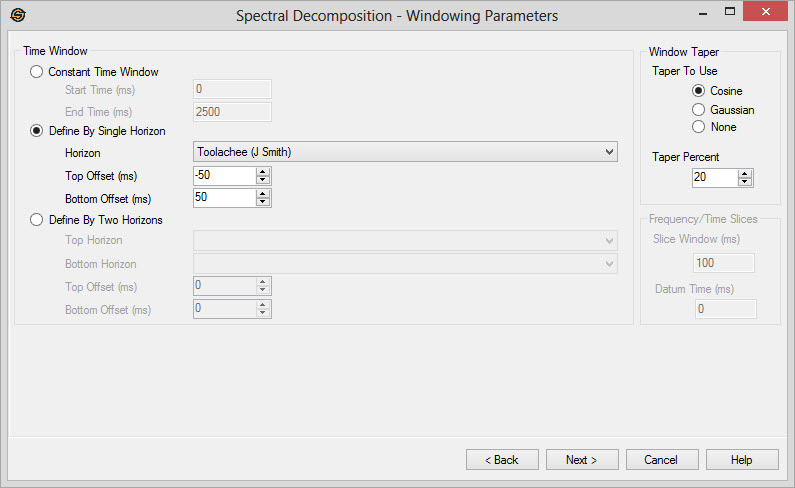Spectral Decomposition: Windowing Parameters
The Spectral Decomposition: Windowing Parameters dialog allows you to select the time window that is used for the Fourier transformation. You can also specify the taper to use for the input data.
Tips for Setting Your Time Window
When running a Discrete Frequency/Time Slice, the slice window should be small, usually around 80 ms to 100 ms and the time window should be larger. The time window and the slice window together determine how many slices the output slice file will contain. Each slice will contain the data for the slice window centered on the time value. For example, for data with a 1 ms sample rate, if you are using a time window from 1000 to 1300 ms and a slice window of 100 ms, the output slice file will contain 300 time slices, with the first slice containing the data from 950 to 1050 ms, the second slice will contain the data from 951 to 1051 ms, and so on, having the last slice from 1250 to 1350 ms.

Time Window
When you are generating a frequency slice, the Time Window is used to define the window of data that is used in the Fourier transformation. When you are generating a discrete frequency time slice, the Time Window is used to define the window over which the Slice Window is moved, and may be much larger than the window used when generating a frequency slice.
Constant Time Window
Use the same time window across the whole volume.
Start Time: Specify the start of the time window in milliseconds.
End Time: Specify the end of the time window in
milliseconds.
Define by Single Horizon
Use a horizon to determine the time window. If there is no value picked for a particular location, than a null will be written to the output file. The Horizon will be assigned the Datum Time regardless of the bulk shift of the input SEG-Y file.
Horizon:Select the horizon used to define the window. This is used in conjunction with the Top and Bottom Offsets to define the Time Window.
Top Offset (ms):Specify the amount of time in milliseconds to add to the horizon in order to define the window. If the value is negative, the window will start above the horizon, if it is position, the window will start below the horizon.
Bottom Offset (ms): Specify the amount of time in milliseconds to
add to the horizon in
order to define the window. If the value is negative, the window will
end above the horizon, if it is position, the window will end below the
horizon.
Define by Two Horizons
Use two horizons to determine the time window. If one or the other horizon has no value picked for a particular location, then a null will be written to the output file. The first slice that is generated will be assigned the Datum Time regardless of the bulk shift of the input SEG-Y file.
Top Horizon: Specify the horizon used to define the top of the time window.
Bottom Horizon: Specify the horizon used to define the base of the time window.
Top Offset (ms): Specify the amount of time in milliseconds to add to the top horizon in order to define the window. If the value is negative, the window will start above the top horizon, if it is position, the window will start below the horizon.
Bottom Offset (ms): Specify the amount of time in milliseconds to add to the bottom horizon in order to define the window. If the value is negative, the window will end above the bottom horizon, if it is position, the window will end below the horizon.
Window Taper
A taper can
be applied to the input seismic data. This tends to
eliminate extra high frequencies that can appear at the edges of the
time window. Note: You
might want to change the shape of the taper depending on the
window size. If you have a larger time window, you might want a more
aggressive taper and if you have a smaller time window you might want a
more gentle taper.
Cosine: Apply a cosine taper to the time window. If using a time window of 100 ms, a 60% cosine taper will use a weight of 0 at the edge of the window, and using a cosine function, scale that up to 1 at 30 ms and then at 70 ms it will start scaling it back down from a weight of 1 to a weight of 0 at 100 ms.
Gaussian: Apply a Gaussian taper to the time window. A Gaussian taper is a bell shaped, normal distribution type curve. It weights the input data from 0 to 1 at the center of the time window and then back down to 0 at the end of the time window.
None: Do not taper the input data.
Frequency/Time Slices
This is only used when generating discrete frequency time slices, and is used to determine the window of data used in the Fourier transformation.
Slice Window: Specify the size of the window used to determine the amount of data used in the Fourier transformation. Note: The Time Window should be larger than the Slice Window.
Datum Time: The datum time is used only when generating discrete frequency time slices. When you are using one horizon to define your time window, this will be the time of the horizon if the horizon is contained within the Time Window. In all other cases, this is the time of the first slice.
— MORE INFORMATION

|
Copyright © 2020 | SeisWare International Inc. | All rights reserved |